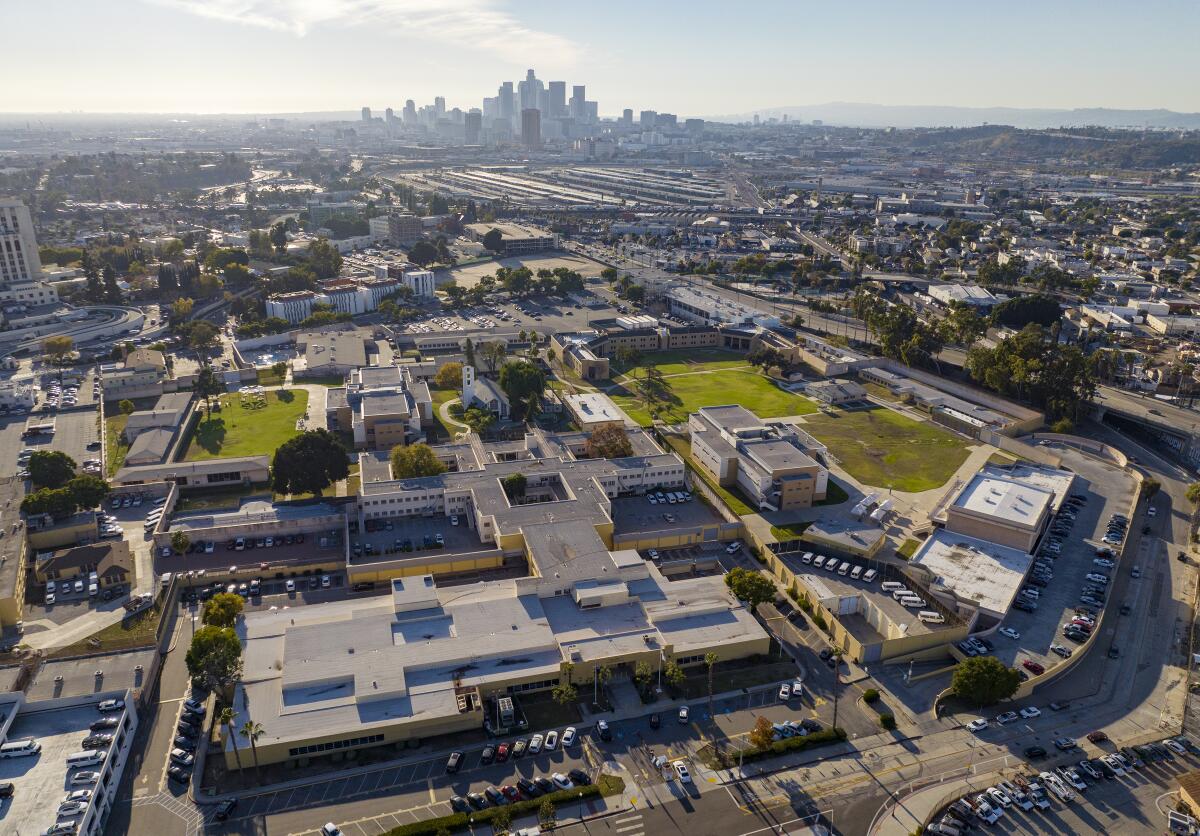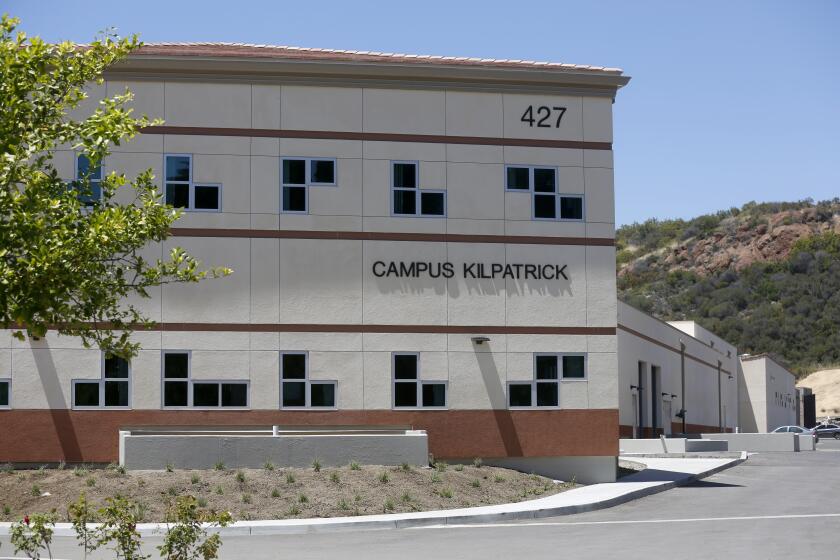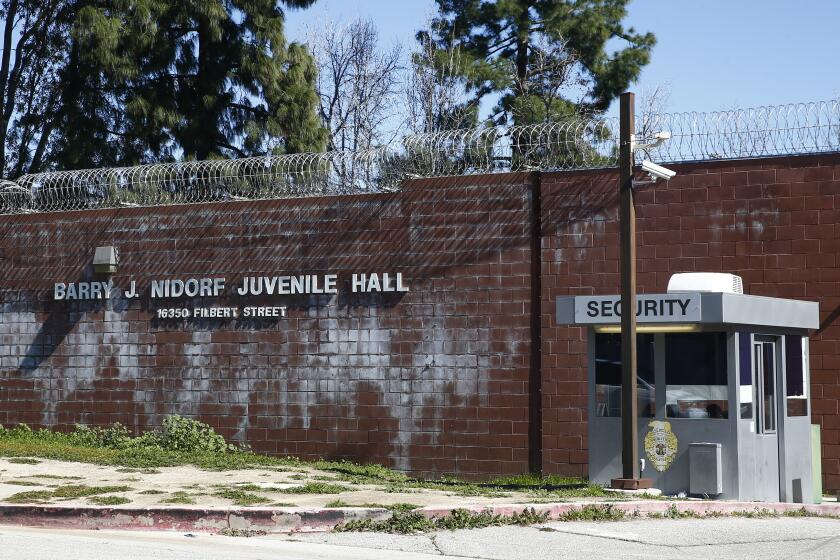Editorial: The real L.A. model of juvenile justice: Delay, disaster, disgrace

At Los Angeles County’s troubled juvenile halls and probation camps, it’s sometimes hard to distinguish between imminent rescue and impending collapse. For example, the Probation Department is transferring 100 less-experienced officers from the field to supplement a juvenile hall staff so diminished by vacancy, injury, fear and contempt for management that barely 11% of officers come to work.
Also, 16 “credible messengers” — trained workers with a history of incarceration, whose time will be paid for by the Anti-Recidivism Coalition and Healing Dialogue and Action — will report this week to the dangerous Barry J. Nidorf Juvenile Hall in Sylmar and the newer, safer, but still struggling Campus Kilpatrick in Malibu to offer young offenders the benefit of their experience. They are being sent by the county’s new Department of Youth Development, which was first envisioned as an agency that could take over all of probation’s juvenile operations as early as 2025. At present, that transfer seems unlikely to happen.
For the record:
8:28 a.m. March 13, 2023An earlier version of this editorial stated that the credible messengers were volunteers. They are paid for their work.
Conditions at Sylmar (almost universally referred to by probation staff, youths and families as Barry J) are dire. Officers work nearly 24-hour shifts to cover for their missing colleagues, leaving them exhausted and short-tempered. Classes and activities are often canceled because teachers and contract service providers are too afraid to come in. Interior walls are covered with graffiti, windows are broken, living quarters are trashed. Juveniles who are accused of crimes and awaiting court hearings have little to do each day but play video games or — because security is lax despite razor wire, guards and X-ray machines — get high on illicit substances that somehow find their way inside. Earlier this month, at least two juveniles overdosed on fentanyl at Barry J and were administered Narcan.
The situation is only marginally better at Central Juvenile Hall near downtown, which like Barry J is meant to hold, protect and educate young people accused of crimes for a few weeks while they wait for their court dates. In fact, some youths linger at the juvenile halls for as long as two years.
The systemic problems at the Los Angeles County Probation Department’s Juvenile Division will not be solved by merely replacing one more department chief.
Problems also plague the handful of probation camps — facilities like Campus Kilpatrick in less-gritty settings where juveniles are committed by courts for longer periods of rehabilitation and treatment. The Board of Supervisors directed Kilpatrick to be rebuilt from the ground up to accommodate a new format of care based on small group settings and consistent staff mentoring. County officials proudly called their program the L.A. Model. But it was never put in place as envisioned because it is incompatible with labor contracts that require work schedules designed to suit officers rather than the juveniles.
The crisis is exacerbated by an influx of young offenders from the Division of Juvenile Justice, part of the California prison system. The state is getting out of the juvenile justice business on July 1, returning the more challenging cases to the counties. The Board of Supervisors had time to prepare for the transition last year but spent it poorly, squabbling over which camp in whose district would have to house the transferred juveniles.
On Tuesday, the supervisors fired Chief Probation Officer Adolfo Gonzales and briefly entertained a series of directives intended to stem the chaos at the halls and camps, but they put off discussion for two weeks. One plan that might have been timely a year ago includes temporarily reopening a third juvenile hall — the currently vacant Los Padrinos in Downey — to relieve pressure on Barry J. Companion proposals include a variety of transfers and remodelings. But the situation was allowed to degrade to the point at which juveniles and staff are in danger and the facilities are falling apart.
Half of L.A. County Probation Department juvenile division workers don’t come to work, and their unions resist change. The county should push forward and replace the division.
The county’s population of incarcerated youth has plummeted, and the greatly diminished caseload ought to have been an opportunity to improve rehabilitation programs for the most difficult juveniles. Instead, having fewer cases has somehow translated into negligent care, absent staff and organizational meltdown.
“We are lucky that no one has died,” Probation Oversight Commissioner Mili Kakani said at a meeting Thursday. “If we’re counting on luck, we don’t have much left.”
At the same meeting, interim Chief Probation Officer Karen Fletcher told the commission — which earlier this month called for her resignation, along with Gonzales’ — that the department was committed to employing the L.A. Model at every hall and camp. But this is the real L.A. Model: a foot-dragging Board of Supervisors, unmet standards, looming deadlines — and unconscionable treatment of youths entrusted by the courts to the county’s care.
The Probation Department is now being scrutinized by the Board of State and Community Corrections, which has power to revoke permission to operate juvenile facilities and is subject to a 2021 settlement with the state Department of Justice, which found alarming failures with detention conditions and education. The intervention is needed.
But it’s worth remembering that a settlement with the U.S. Department of Justice more than a decade ago over similar deficiencies resulted in short-lived improvements followed by a return to dysfunction. If state oversight fails to impose lasting improvement, there will be little choice but for the feds to return, this time with a civil rights action and a consent decree, and a lot less tolerance for objections by probation employees and county supervisors.
More to Read
A cure for the common opinion
Get thought-provoking perspectives with our weekly newsletter.
You may occasionally receive promotional content from the Los Angeles Times.












